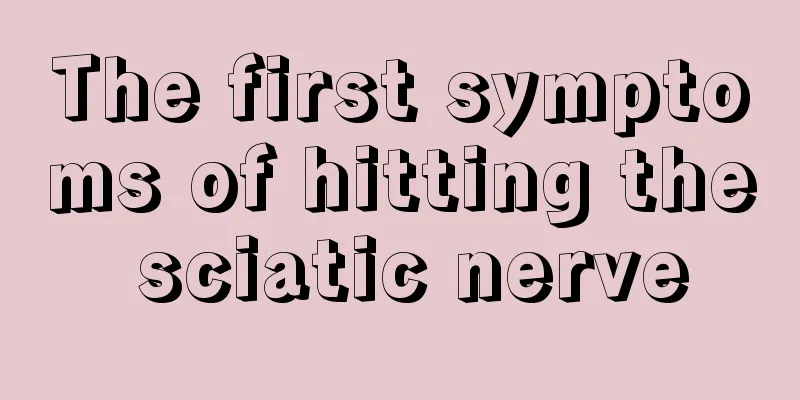The first symptoms of hitting the sciatic nerve

|
Many diseases have some symptoms at the beginning. Sciatica is a disease that plagues middle-aged and elderly people. So, when the disease is not yet serious, will the patient's body show any signs that can allow everyone to take precautions in advance? If you want to treat and prevent sciatica in a timely manner, you must first understand the common symptoms of different types of sciatica. Sciatica refers to radiating pain along the distribution area of the sciatic nerve, mainly in the buttocks, the back of the leg, the posterolateral side of the calf, and the outer side of the dorsum of the foot. It is a symptom caused by various diseases and is divided into root and pain. Sciatica is a syndrome characterized by pain along the sciatic nerve pathway and distribution area. The vast majority of sciatica cases are secondary to lesions in the local sciatic nerve and surrounding structures that cause stimulation, compression and damage to the sciatic nerve, which is called secondary sciatica; a few are primary, namely sciatica. Sciatica is a common disease caused by compression of the sciatic nerve. The sciatic nerve is made up of several different spinal nerves, including the fourth and fifth lumbar nerves and the first to third groups of nerves. This nerve runs from the lower back, through the buttocks, to the back of the thigh, calf, and foot. When the sciatic nerve becomes compressed, pain can develop in this nerve, causing symptoms of sciatica. Although the sciatic nerve originates in the lower back, most people with sciatica do not complain of lower back pain. The pain is usually felt in the arms, thighs, or calves. Common symptoms This disease is more common in young and middle-aged men. In recent years, it has become particularly common among people who work in offices and use computers for too long. Symptoms include: mostly unilateral pain, the degree and duration of pain are often related to the cause and the severity of onset. Radicular sciatica Symptoms: The onset varies depending on the cause. The most common lumbar disc herniation often has an acute or subacute onset due to factors such as exertion, bending over or strenuous activity. A few have chronic onset. The pain often radiates from the waist to one side of the buttocks, back of the thigh, popliteal fossa, outer side of the calf and foot, and is burning or knife-like. The pain may be aggravated by coughing or exerting force, and is worse at night. In order to avoid nerve traction and compression, patients often adopt special pain-relieving postures, such as lying on the healthy side with hip and knee flexed when sleeping, and focusing on the healthy side when standing. Over time, this will cause scoliosis, which bends more toward the healthy side, and when sitting, the buttocks tilt toward the healthy side to reduce pressure on the nerve roots. Stretching the sciatic nerve can induce pain or aggravate the pain, such as a positive Kernig sign (the patient lies on his back, first flexes the hip and knee to a right angle, and then lifts the calf. Due to flexor spasm, knee extension is limited to less than 130 degrees and there is pain and resistance); a positive straight leg raising test (Lasegue sign) (the patient lies on his back, extends the lower limb, and lifts the affected limb to less than 70 degrees, causing leg pain). There may be tenderness along the sciatic nerve pathway, such as the lumbar points, buttock points, midpoints, ankle points and plantar points. There is often numbness and decreased sensation on the lateral side of the calf and dorsum of the foot. The gluteal muscle tone is relaxed, and the extensor and flexor muscles are weakened. The Achilles tendon reflex is weakened or absent. Dry sciatica Symptoms: The severity of onset varies depending on the cause. If it is caused by cold or trauma, the onset is usually acute. The pain often radiates from the buttocks to the back of the thigh, the posterolateral side of the calf, and the outer side of the foot. The pain worsens with walking, movement, and traction on the sciatic nerve. The tenderness point is below the buttocks, the Lasegue sign is positive but the Kernig sign is mostly negative, and the scoliosis is mostly bent toward the affected side to reduce the traction on the sciatic nerve trunk. Radical method: Use safe and effective minimally invasive methods. This technology uses the essence of traditional Chinese medicine combined with Western medical concepts. It only takes a few seconds to use advanced instruments to reach the lesion directly, produce mechanical stimulation, loosen adhesions, contractures and scars of soft tissues, improve blood circulation around the knee joint, promote blood return, and restore the mechanical balance of soft tissues around the joint, thereby facilitating self-repair. |
<<: How to determine dental nerve necrosis
>>: What to do if wisdom tooth extraction damages nerves
Recommend
How to treat pancreatic cancer liver metastasis
Some pancreatic cancer patients will develop live...
What diseases does Cheyne-Stokes respiration occur in and what are the symptoms
Generally speaking, when the patient's condit...
What does the skull include
The skull is a very important bone part in the hu...
Which green tea tastes best? How does it taste
Green tea is a common type of tea, and there are ...
Can we eat soon?
The speed of eating actually has a great relation...
When to eat dried persimmon
Although persimmon cakes are very delicious, ever...
Tips to remove the fishy smell of duck
How to make beer duck 1. Wash the duck and cut it...
The last symptoms of gallbladder cancer
There are many situations and characteristics of ...
What can I drink to sober up the fastest?
We must drink in moderation in our daily lives. I...
What are the signs that depression is getting better? Do you know all of these?
As society develops faster and faster, we can see...
If breast cancer recurs after five years, is there a high probability of metastasis?
If breast cancer recurs after five years, is ther...
How to prevent the recurrence of lymphoma
There are quite a few patients with lymphoma in m...
Why does my whole body feel numb when I’m angry?
Many of our friends always can't help losing ...
Is it serious if thyroid cancer does not cause pain or itching?
Thyroid cancer patients do not feel pain or itchi...
Traditional Chinese medicine treatment against pancreatic cancer
Effective methods of TCM treatment of pancreatic ...









